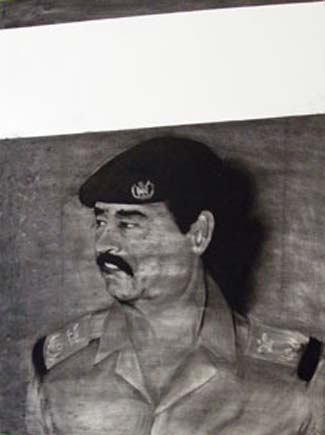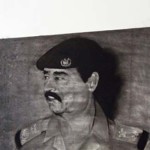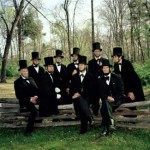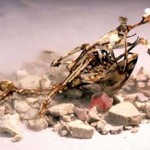By CHRISTIAN HOLLAND
History will be interpreted differently by different individuals and communities. It goes without saying. In fact, "History" is an interpretation, an interpretation of the past. MassMoca’s show, "Ahistoric Occasion: Artists Making History," brings together a group of artists who each examine the past and ways to depict it.
The interpretive aspect of History is no more foregrounded in any of the works in the show than Greta Pratt’s portraits of members ofThe Association of Lincoln Presenters show individual interpretations of Abraham Lincoln by enthusiasts of the 16th president. Not only does each "Lincoln" look markedly different as the various body types and facial structures come through with each presenter, but each Lincoln aficionado iterates the president’s semblance along their personal interpretation of the past. The show takes it name from Paul Chan’s Ahistoric Occasion, Happiness (finally) after 35,000 Years of Civilization – after Henry Darger and Charles Fourier (2000), but the work’s abstruseness and obscurity—it is a flash animation of Darger-esque imagery in Fourier-esque world rendered as if for a 8-bit Nintendo with an 8-bit version of Jay-Z’s Big Pimpin’—prevent it from the more unequivocal implications of Pratt’s images. Elsewhere in the show, charcoal drawings by Chan titled On Democracy recreate images of Saddam Hussein pontificating on democracy as viewed by his citizenry on Iraqi television in the 1970’s. The charcoal aptly renders the lo-fi video look of 70’s Iragi TV, but the works are trite: how many instructors of core-curriculum drawing classes have witnessed Saddam’s image as translated in charcoal through their students’ hands?
Jeremy Deller recreated the Battle of Orgreave in the same way that Civil War reenactors and film directors recreate historic battles for education and entertainment. In general, the major differences were that the battle took place only 17 years before the film was made and the battlers were not soldiers but 5000 striking miners and police in Sheffield, England. The film touched on the nerves of British people as the national consciousness had not yet grown comfortable with the events which clearly affirmed the immense divisions between the British government and its people. In this case, the reenactment, like many war films, allows for a national catharsis as the British people were enabled to revisit past events which scared their national identity.
Yinka Shonibare also uses reenactment to recreated the 1792 assassination of the Swedish King Gustav III in his film, Un Ballo Maschera (A Masked Ball) (2004). Essential to the piece are the actors’ costumes, which are styled in typical Baroque fashion yet non-gender-specific and made of African batik fabrics. Influenced by his own past as a "truly bicultural" individual, Shonibare appropriates these two disparate subjects in addition to having his actors play out the assassination in rich choreography in both backwards and forwards order. The result is an "ahistoric" ballet in which both the narrative of History and its historic components are purposefully distorted, but somehow enrich our understanding of the past.
Going further into the appropriation method, in terms of both the extent of historical objects appropriated and the shear peculiarity of the appropriation, Dario Robleto literally melds "the material stuff of [H]istory"[1] in with a coherence that creates allegorical works that are both about the past and History itself. Evidence of the past, the objects that we write histories from, is pulverized and melted then molded together into new forms. In War Pigeon With a Message (Love Survives the Death of Cells) (2002), Robleto uses actual materials from carrier pigeon technology of World War I including masonry rubble, a bullet to go along with the pigeon skeleton with attached unopened message and id bracelet. In Our Sin Was In Our Hips (2001-2002), Robleto took ground pelvis bones and melted records from each of his parent’s collections and created two molded pelvis bones—one male, one female depending on whether the records used were his father’s or mothers, and stacked them on one another. He continues the method of bone dust appropriation throughout his war themed works as well, yet considering the significance each ingredient has in every one of his works and the clear allegories he creates, it is ironic that the bone dust donations are anonymous.
The discursive frame of History as a launching point for an open discussion by artists will invariably be ambiguous, though the methods employed by artists—there is a seemingly countless amount—are valuable for restating and refiguring histories in a way not already done. "Ahistoric Occasion" attempted to couch its importance in our current state of affairs as an audience of a quickly evolving Mass Media and as citizens of a government that has not learned from its past mistakes, but in truth, all history is political. Artists’ attempts on History will always be inherently radical (or reactionary)—think Picasso, some Pop Art or even Science Fiction—yet History’s place as point of discussion bears no more significance today than it ever has. The curator, Nato Thompson, cited television shows such as PBS’ Colonial House and Frontier House as examples of the public’s current interest in History. However, those shows’ market sizes are small and the shows themselves are merely following the cues of the substantially more popular network Reality shows and redressing them as educational. The cliché "…bound to repeat history" won’t ever lose its relevance.
The show fell far short of its ambitions to critique the contemporary Mass Media—Paul Chan’s On Democracy drawings come closest—yet it did successfully critique History as a way to understand the past. History as progress, truth and narrative are all called into question. The popular methods such as reenactments, re-telling for theatre or screen, as well as the invention of new methods to describe and discuss the past, were brought together via a survey of strong works that each provoke us to reconsider our understanding of the past and, which could have stood well on their own.
- Paul Chan, On Democracy, 2006.
- Greta Pratt, Nine Lincolns Hodgenville, Kentucky, 2000.
- Dario Robleto, War Pigeon With a Message (Love Survives the Death of Cells), 2002.
----
[1] - From the exhibition pamphlet.
"Ahistoric Occasion: Artists Making History" was on view through April 22, 2007 at the Massachusetts Museum of Modern Art.
All images are courtesy of the artist and MassMoca.






